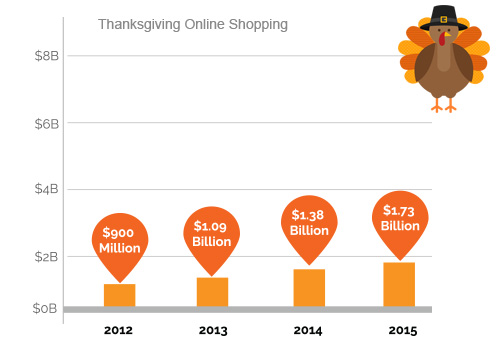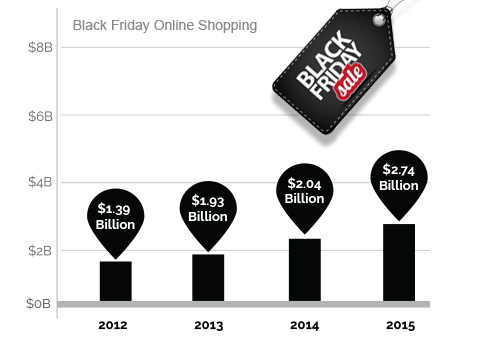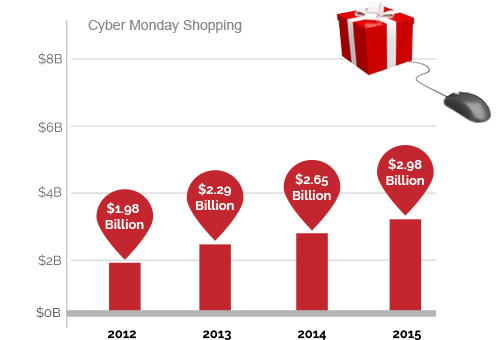
From Black Friday to Cyber Monday: The Final Sales Results of the 2015 Holiday Shopping Weekend
How did the final results of Black Friday and Cyber Monday compare to the analysts’ expectations? Did sales follow the expected trends? Were there any surprises? Letdowns?
Holiday Shopping Overview
The 2015 holiday shopping season kicked off with what many had hoped would be record breaking sales during the Black Friday weekend. The 5-day shopping push met expectations; however many were surprised at what analysts found.
The trend towards online shopping continued as retailers relied more on web-based marketing and sales opportunities. Traditional shopping was strong as well, indicating that despite convenience, many consumers enjoy the thrill of the hunt.
Results were mixed in a US versus UK comparison, with the US clearly leading the way in Black Friday shopping frenzies.
Retailers in the UK were prepared for large crowds, with increased staff and security measures, but largely found that consumer turnout was similar to that of any other shopping day. Few retailers reported heavy lines, and in one instance, the only people lined up early to grab bargains were reporters hoping for a story.
US shoppers did not disappoint, however, and turned out in droves: 151 million shoppers went in search of deals they could not pass up.
A Day-by-Day Breakdown
Let’s take a look at the daily shopping activity and how each day impacted the weekend’s overall sales results.
Thanksgiving Day
Sinks around the US were still filled with dishes as consumers headed off on another Thanksgiving tradition: early Black Friday shopping.
Nearly 35 million people shopped on the holiday, despite the effects of eating large amounts of turkey. In an attempt to find bargain pricing on electronics including TVs, computers, tablets and wearables, shoppers hit the streets early Thursday afternoon. Many more turned to the internet to snag deals offered by retailers hoping to capitalize on the growing online marketplace.
As a push against consumerism, many retailers advertised a return to family values, promoting ‘Buy Nothing’ days, encouraging consumers to hug (in the UK) or simply enjoy the holiday without shopping. Many consumers took this message to heart.
Black Friday
US shoppers slowed down a bit in 2015, with $12.1 billion in sales (vs. $12.9 billion in 2014) during Thursday and Friday’s sales.
Many retailers stretched the shopping holiday out both before and after Black Friday by offering ‘Black Friday pricing’ during the week leading up to the shopping day. Because of this, it may not be until January that the overall results of the shopping holiday are known.
As the UK kicked off its holiday shopping season, online sales on Black Friday topped $1 billion, an increase of over 35% from last year. This huge uptick in online shopping demonstrates the UK consumer’s adoption of convenience and what many are attributing to mass chaos during last year’s Black Friday sales. Black Friday sales set a record of being the biggest day of online shopping in UK history.
Cyber Monday
While the brick-and-mortar sales were sluggish this year, 2015 was a record-setting year for Cyber Monday sales.
For the first time ever, Cyber Monday topped $3 million in online sales. Consumers embraced the convenience of shopping online, particularly as many in-person deals were matched online.
Typically the biggest UK shopping day, the first day of December is considered the start of the holiday shopping season. In 2014, Black Friday took over as the leading online day. In 2015, Cyber Monday saw a 31% growth, putting it in close second to the record breaking day. Nearly $6 billion was spent during the four day shopping push.
Interestingly, shopping occurred consistently during the day, without the traditional peaks that happen during lunch breaks or the dinnertime slowdown.
Notable Weekend Trends
Shoppers let their fingers do the walking this year, with nearly half of all weekend online traffic attributed to mobile sales and 27% of Cyber Monday’s online sales.
Mobile shopping was not the primary means of online shopping, but saw a 70% growth over last year. Many retailers were getting into the mobile shopping act by offering specialized apps, coupons and bargains that were accessible through email and text messaging.
According to USA Today, there was a shift among retailers trying to establish both online and offline sales. Historically, few retailers offered online sale items; however, the 2015 shopping weekend saw major retailers offering the same sales items on their websites, allowing consumers to get the benefit of the sale without leaving home.
Consumers showed a preferences for online shopping over brick-and-mortar; only 102 million shopped in-person while 103 million shopped online. Total weekend shopping for brick-and-mortar retailers were $20.4 billion, while online sales topped $11 billion.
The stark numbers don’t convey the big picture though; the YoY comparison for brick-and-mortar showed a 10% decrease in sales figures while online YoY showed a 26% increase.



Other highlights include:
- Women turned out in higher numbers than men, with 66% of shoppers being female vs. 34% male in the UK, and similar numbers reported in the United States.
- The biggest draw for shoppers was electronics on both sides of the ocean. TVs, tablets and the Apple watch were hot ticket items, with Star Wars toys following closely behind.
- UK shoppers turned out for wearables (with a 932% growth), Lego and Dyson products, as well as tablets and mobile devices.
The Downside of Bargain Hunting
Many retailers reported lackluster crowds at their Black Friday sales, particularly in the UK. However, all around the globe, websites crashed as shoppers flocked to cyber sales throughout the weekend. During Black Friday’s hottest shopping times, websites took up to 10 seconds to load, an eternity in online shopping where industry giant Amazon boasts of a 0.5-second load.
No matter where shoppers were in the world, consumers weren’t the only ones out in full force during the shopping weekend. Greater shopping opportunities also mean greater opportunities for cyber fraud. In the UK, police made arrests as criminals utilized ‘diagonal brute forcing’ in an attempt to hack accounts. By using previously obtained passwords and account information, fraudsters would check different store websites to see if the information worked.
One can expect to see more online credit card fraud as brick-and-mortar retailers in the US complete the switch to the new EMV card standards. With the new chip technology making it more difficult for fraudsters to use counterfeit cards and stolen information in traditional stores, they will be turning to the internet to seek opportunities for theft.
On both sides of the Atlantic, shoppers were in search of bargains that they couldn’t find anywhere else. Most analysts agree that the Black Friday shopping weekend is no longer an indicator of holiday season sales.
This is due, in part, to the extended sales opportunities presented to consumers through online bargains that lasted beyond the 5-day weekend. Overall, analysts expect the holiday shopping season to see a 3.7% increase in sales from the feedback of the weekend.
For retailers trying to attract every sale they can during December, Black Friday was a great jumpstart to what is shaping up to be a busy month of sales.
